Run TMC Lives on as the Rare Team Celebrated for Style Rather Than Record

This story appears in the July 2, 2018, issue of Sports Illustrated. For more great storytelling and in-depth analysis, subscribe to the magazine — and get up to 87 percent off the cover price plus two FREE gifts. Click here for more.
***
Mitch Richmond arrives first and settles into a blue lounge chair inside a hotel suite 11 floors above downtown San Francisco. He starts with a confession: Yes, he had donned workout gear that afternoon, gone to the gym, stretched, bent toward an exercise mat—and then decided against physical activity. He’s 52 now. Getting older. “My hip was killing me,” he says.
His former Warriors teammate, Tim Hardaway, is 51. He opens the door shortly after Richmond’s confession, and he’s wearing a pinstripe blue suit and walking with a slight limp, a reminder that he needs right-knee replacement surgery. In that moment it’s almost possible to forget what they were, or why they’re in town, for Hardaway’s induction into the Bay Area Sports Hall of Fame, in part for his brilliance with Run TMC, the most electrifying, ahead-of-its time, hipster-celebrated trio in NBA history.
Run TMC reigned as Warriors back when tickets were affordable to longtime fans, before Steph and KD, the dynasty and the plans for the $1 billion new arena. They’re older now, a little rounder and wiser too. Allegedly. Word reaches the suite: The C in Run TMC is running late. Apparently he dropped his cellphone in a hot tub and was last seen, disoriented, inside an Apple Store. “That’s Mully,” Richmond says of Chris Mullin, who is 54 and prone to iTurnovers.
Exiled by the Cubs, Sammy Sosa Is Enjoying the Life He Wants You to See
Sore hips, bad knees and lost phones. Sounds like a Netflix comedy. Or proof, finally, almost 30 years later, that Run TMC is more like the rest of us, even if the two seasons they played together would suggest otherwise. These were the Warriors before these Warriors, the creation of coach Don Nelson and his early brand of small ball. The trio debuted in 1989–90, near the end of the Showtime-era Lakers, before Jordan came to rule. They had three offensive luminaries, spot shooters and even a point-forward. Sound familiar? Their coach preferred a frenetic pace, a motion offense and 50-point quarters. Remind you of anyone? Nelson wanted to earn fans free pizza, which happened if his Warriors scored 120 points. “Nellie was ahead of his time,” says Rod Higgins, a versatile forward on those teams. “He saw where basketball was going.”
“[Mike] D’Antoni gets the accolades for what we [were already doing] back in the day,” Hardaway says of the Rockets’ coach, who is credited for a large role in the small-ball revolution.
“No, that was us,” Richmond says.
How soon the uninitiated can forget. The night before Hardaway’s induction, Run TMC attended Game 3 of the Western Conference finals between D’Antoni’s Rockets and the latest title-bound Warriors team. The Dubs played a highlight montage—all fast breaks and killer crossovers—on the Jumbotron and the crowd gave the trio a standing ovation. But when the threesome decamped to a suite later, the guard outside asked Hardaway for his pass. Apparently this guard never saw Hardaway dunk over Kareem or talk smack to Shaq. “I’m Tim Hardaway,” he said, pushing past. “That’s my pass.”
“People don’t know their history,” Richmond says.
Lori Hoye does. She started in the Warriors’ statistics department in 1988, the year before Run TMC formed. That was the first season the NBA tracked statistics on computers, which meant some nights she felt like a bobblehead, head bouncing from court to computer, trying to keep up with the statistics Run TMC was accumulating.
Hoye doesn’t agree when asked about Dennis Rodman’s assertion (to CBS Sports radio in April 2017) that those Warriors would beat, or even hang with, these Warriors. But sometimes, Hoye admits, “I tell Steph that Tim did all that stuff before he did.”
Alas, Run TMC never realized the full extent of its potential greatness in those mildly successful yet wildly enthralling seasons. What they did do was carve out an odd, memorable and brief space in NBA history as a team celebrated for its style rather than its record—a rarity back then. To watch those Warriors and then watch these Warriors is to trace both the history of a franchise and the evolution of pro basketball.
Where is Run TMC now? Everywhere, in terms of influence.
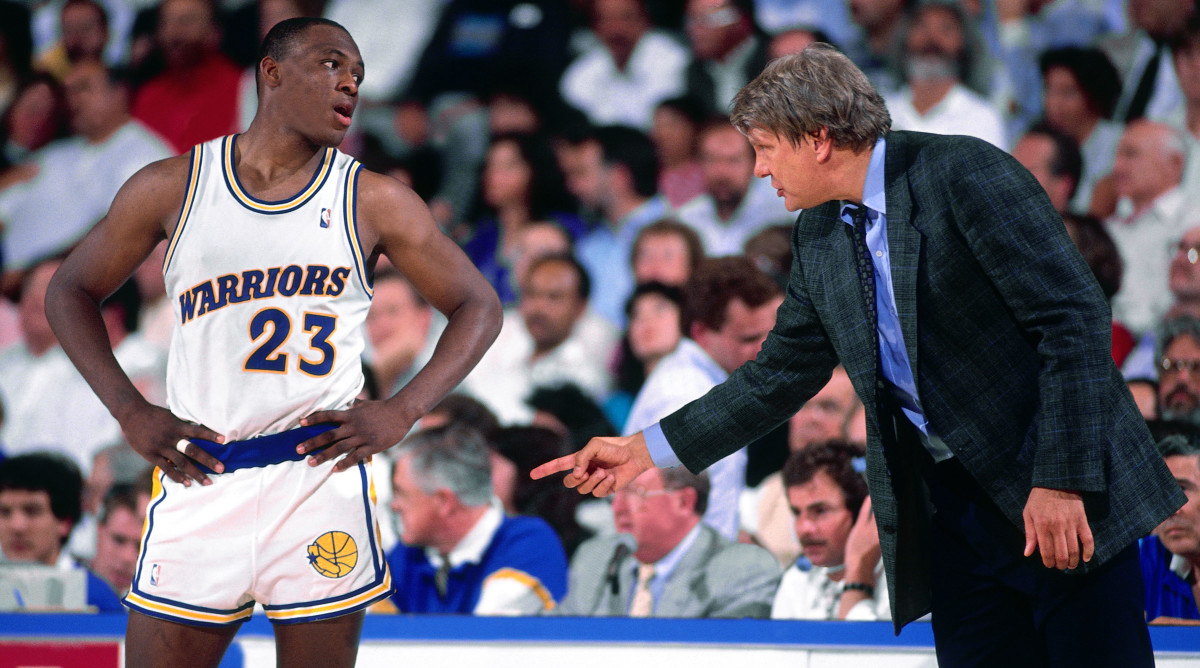
The Warriors selected Richmond, the 6'5" scoring savant from Kansas State, with the fifth pick in the 1988 draft. He went home to Florida and spread the news. Golden State had taken him. “Don’t worry about it. One day you’ll make it to the NBA,” his mom’s friend told him.
“No, Golden State is in the NBA,” he responded.
Richmond knew of Mullin. He’d watched him star in college, at St. John’s, and later he played against him in an Olympic training exhibition. “I remember trying to guard him, and he takes one step around me, like he’s in slow motion,” Richmond says. “Then he scores. I’m like, Jesus, that was slow. But I couldn’t stop him.”
Few could. Mullin was a 6'6" forward who could thread passes between defenders and score from anywhere on the court, if not win 100-meter dashes. He had spent three seasons with Golden State at that point, emerging as a 20-point-per-game scorer. In 1988–89, with only M and C, the Warriors won 43 games and a first-round playoff series. Mullin made his first All-Star team, averaging 26.5 points per game, and Richmond nabbed Rookie of the Year honors.
The Warriors had found two superstars. The only thing better than that? Three.
Hardaway considers all of this inside a booth at the radio station 95.7 The Game on the afternoon of his induction. The red light next to his microphone is on, and he’s reliving that next spring, and how he missed his workout for the Warriors ahead of the 1989 draft because a lightning storm shut down the airports in his hometown of Chicago. He found out later that Nelson had been telling the teams who picked above the Warriors that the guard from UTEP had bad knees. He fell to Nellie with the 14th pick.
The Greatest Team Never to Make It: An Oral History of the 1998 Vikings
After ignoring Nelson’s pleas to change his knuckleball of a jump shot, Hardaway accepted, with some trepidation, his coach’s challenge to “quarterback” an established playoff team. He tells the hosts about the time he watched Mullin make every shot for two hours, scoring something like 80 points in one practice. Nelson wanted Hardaway to lead him?
Suddenly there’s a caller on the line. It’s “Chris,” from a bike path somewhere outside San Francisco. Mullin’s cellphone is now apparently chlorine-free—for now. They’re both laughing as Mully tells listeners of the time he saw the 6-foot Hardaway sink a hook shot over Kareem Abdul-Jabbar. “And not only making that but telling him about it too,” he says, adding, “Tim’s the most competitive guy I ever played with. Most talkative too.”
The stories continue. How Hardaway would show up earlier and earlier every morning in an effort to beat Mullin to the Stairmaster, only to find the veteran had invariably finished his workout. How Nelson ran them through 30 two-a-day practices before the season started, conditioning his team for the chaotic pace that he preferred they play. How Hardaway’s killer crossover rolled ankles in every practice.
In that first season of Run TMC—though the name hadn’t been coined yet—Golden State led the NBA in scoring, averaging 116.3 points per game. (Sound familiar?) Fans had a pretty good shot at pizza every night. “The Warriors now are like that,” Richmond says. “Four guards, one big man, spread the floor and move. I’m like, that’s us!” Except these Warriors, without fail, make the playoffs. Those Warriors, who gave up a whopping 119.4 points a night, did not.
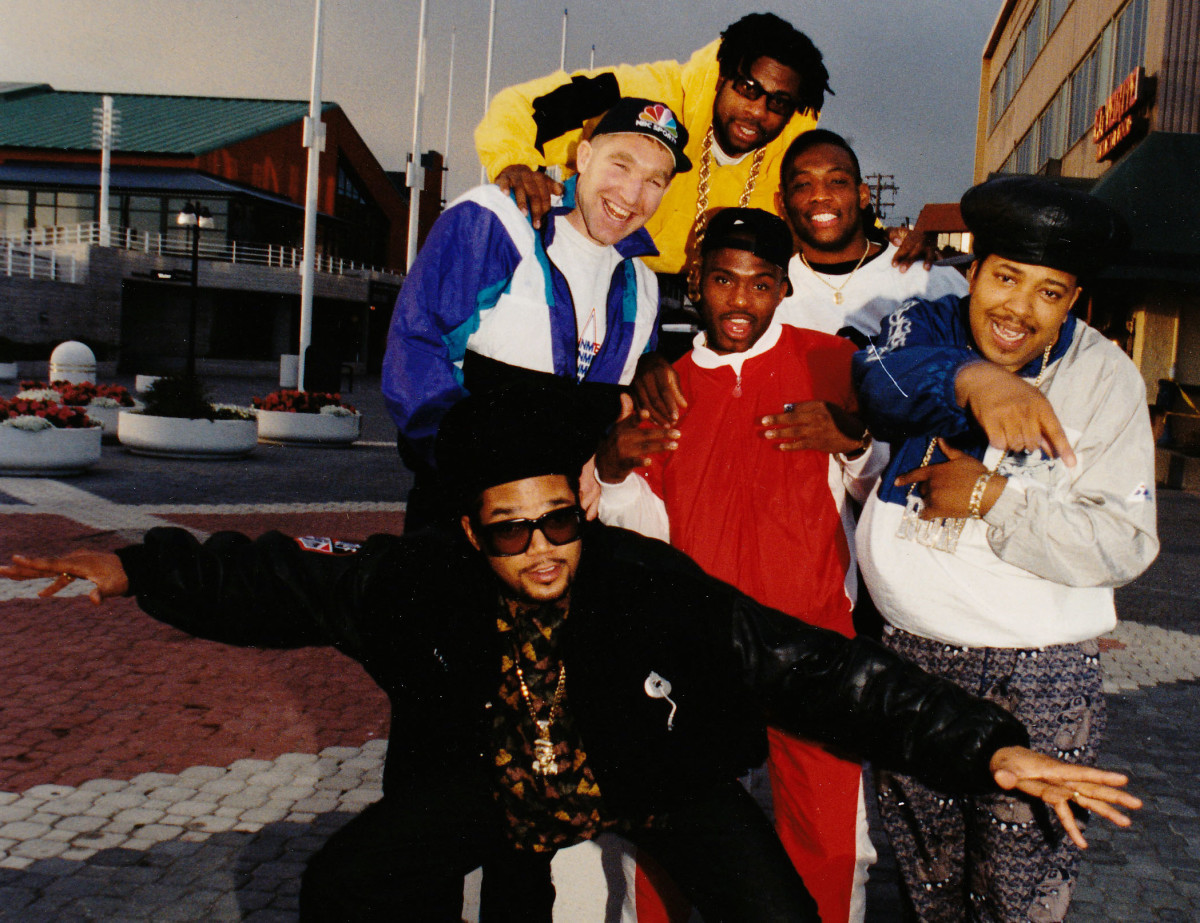
Run TMC knew right away that it could and would score at will, regardless of the players or scheme it was facing. But it only looked effortless. A lot of work went into making it appear that way.
In practice Nelson played the Warriors out of position. He’d put Hardaway at the four and Richmond at the five, then quiz them the next day. He wanted them to be open to the unconventional, to understand the flow of the entire system rather than just their individual assignments. He told Hardaway to bring the ball up, let everyone else touch it, and if none of his teammates shot, then go to the basket and score. That was his “dance time.” This wasn’t James Harden dribbling to infinity. This was Hardaway, dribbling and dishing, dribbling and dishing, driving as a second or last resort.
The Warriors did have an extensive playbook. But for some games they ignored it altogether, using a simple motion offense, screening for jump shots, looking for backdoor cuts and open threes. (Sound familiar?) They took advantage of the illegal defense rules in place back then by placing two shooters on one side of the floor and stacking Run TMC on the other, where their opponents could not legally play zone.
Because they played with panache, running and gunning and scoring as if controlled by video game joysticks, the locals couldn’t turn away. In Run TMC fans saw unbridled joy, a stylistic juggernaut. They figured the wins and championships would follow and assumed the trio needed only one more element: time.
Buyer Beware: Think Twice Before Signing These Five NBA Free Agents
The Warriors bolstered that flash with obsessive preparation. Run TMC would play two-on-two for hours before and after practice, with Run-DMC’s hits bumping from whatever portable boombox they could find. Nelson often had to chase them off the court. In the first game of that 1990–91 season, the Warriors scored 162 points, defeating the Nuggets by four in the highest-scoring regulation game in NBA history. Golden State sold out every home game that year. The rest of the NBA came to realize what Bay Area fans already knew—that three basketball addicts wanted to break the scoreboard. In the spring the local press decided that this trio, like every great threesome (Charlie’s Angels, the Three Stooges), needed a nickname. Most suggestions were rejected (the Joint Chiefs of Stats; Blood Thirsty Gym Rats from Hell; Heat, Meat and Sweet. ) But one . . . Run TMC. Oh, yeah. They all nodded in agreement.
Fans carbo-loaded on free pizza. But many nights also highlighted the Warriors’ limitations. Namely, defense. Or their lack of it.
Sometimes that didn’t matter. Run TMC averaged 72.5 points a game that season, the highest scoring mark for a trio in league history (until it was surpassed by Steph Curry, Kevin Durant and Klay Thompson each of the past two years). All three ranked in the top 11 in scoring. The Warriors won 44 games and took out the second-seeded Spurs in the first round of the playoffs, using that three-on-three system to isolate a young David Robinson on the opposite side of the floor. “That series,” Hardaway says, “showed what was possible for us.”
They met the Lakers in the next round. Run-DMC joined the Warriors on the team bus and introduced them before games. Hardaway thinks that was a mistake. He heard later that Magic Johnson gathered his team and told them that Run TMC “thinks this is a show,” that “they’re insulting us.” Los Angeles won the series in five games, but the trio had converted thousands to their score-score-and-score-some-more approach. “I felt like we were one piece away at that point,” says another of those Warriors, Mario Elie. “I mean, we had Run TMC.”
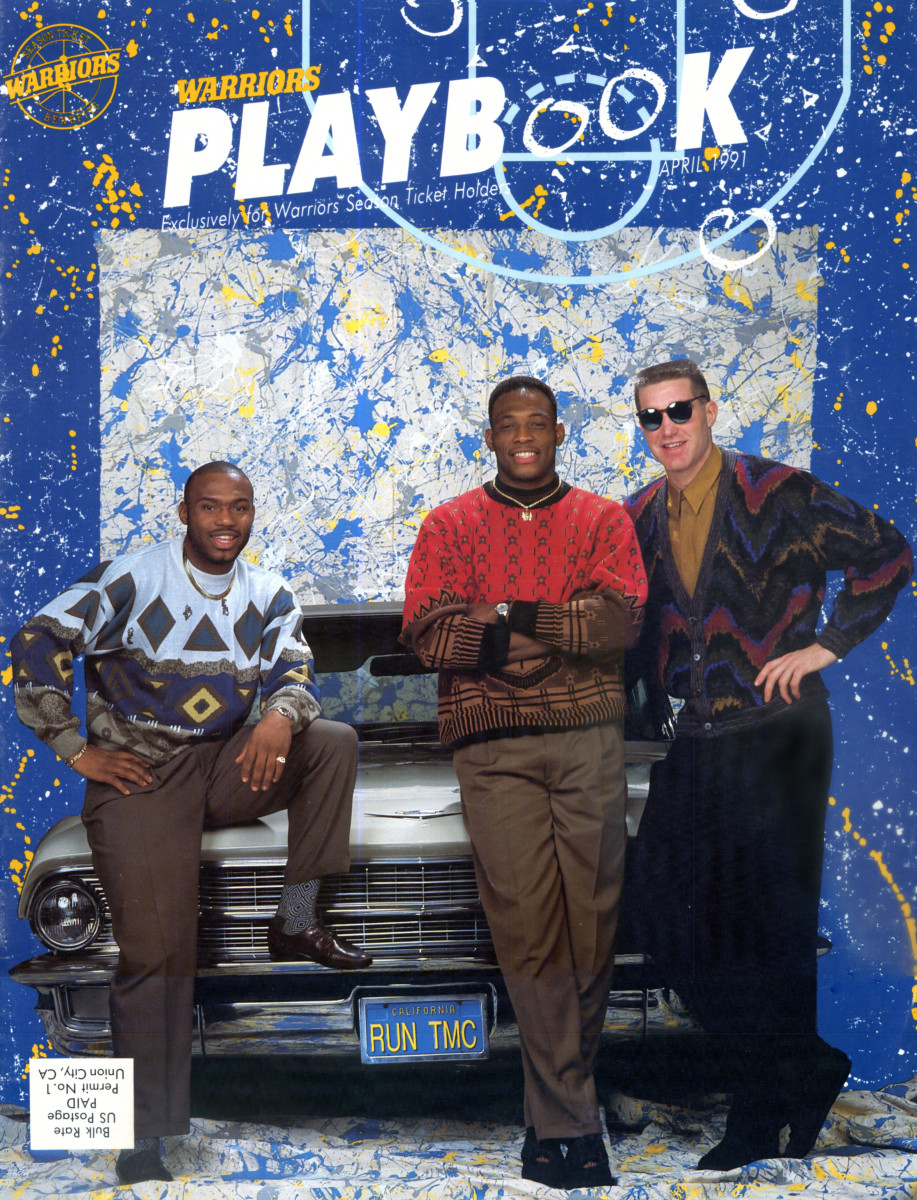
Before the 1991–92 campaign commenced, the Warriors figured their window was opening wider. Only Richmond wasn’t sure. He knew that Nelson didn’t appreciate the time Golden State played in the Boston Garden and Nelson pointed out the number 19 hanging in the rafters. That was his number, he told Richmond. “You played, Coach?” Richmond asked. Another time the two fought over a benign defensive sequence. “If you think you know everything,” Nelson told Richmond, “you f------ coach the team tomorrow.” So Richmond did. He carried a cup of coffee onto the court and started to goofily run practice, pushing out his stomach and “acting like I was drunk.” Then he looked up at the stands and there was Nelson, glowering at him.
Richmond felt underpaid. He wondered who Nelson thought the best player on the team was. “Chris Mullin,” Nelson answered. “Fine,” Richmond responded. “If he just signed for $3.3 million, I’ll take three [million].”
Still Richmond flew with the team to Denver for the season opener on Nov. 1. He was getting dressed at the hotel, readying to head downstairs to catch the team bus to the arena, when Nelson summoned him to his room. Richmond had heard rumors that he was on the trade block, that Nelson felt Golden State needed frontcourt help for his small-ball experiment to succeed, that Sacramento was a possible destination.
The door to Nelson’s room was open. Richmond stepped inside. He remembers Nelson was sitting on the air conditioner near the window. “Don’t tell me you traded me to Sacramento,” Richmond said.
“I traded you to Sacramento,” Nelson responded. For forward Billy Owens. Richmond turned around and walked out.
Nelson announced the trade on the bus. “We were numb for a while,” Hardaway says. “We didn’t recover from that to tell you the truth.”
NBA Free Agency 2018: Top 50 Players Available
After beating the Nuggets, Golden State went home to play—of all teams—the Kings. Richmond walked into the wrong locker room on muscle memory and left, taking a long drive. “The [Kings] lost by 62 that night,” he says. “I cried like a baby. Didn’t get no sleep.”
The trade changed everything, ending the Run TMC experiment before the trio could properly claim its place in NBA lore. Hoops historians have to choose whether to judge the threesome on its record together (81–83) or what might have been, the possibilities at once limited (by the team’s frontcourt and defensive issues) and limitless (the Warriors did average almost 120 points). It is too simple to dismiss the trio and too easy to romanticize it and so Run TMC has settled into a weird historical space, closer to beloved than forgotten, but always with a disclaimer: the greatest NBA trio that only played together for two seasons.
The counterargument to that sub-.500 mark, according to T, M and C, is that they were not given nearly enough time. What if they had kept Richmond and added another piece? Years later, Higgins says Patrick Ewing told him the Warriors had tried to trade for him around the same time they shipped Richmond to Sacramento. Imagine Ewing in the mix: Small ball and so tall. Maybe Jordan wouldn’t have six championship rings.
Both Richmond and Hardaway say they longed for the Run TMC vibe the rest of their careers. Both agree they should have won at least one title, and Nelson’s eventual admission that trading Richmond was a mistake only reinforced that belief. “People don’t realize that it’s much easier when you play with a group of guys who can play like that,” Richmond says. “That’s what Durant is going through now. It looks easier than it was in OKC. That’s because it is.”
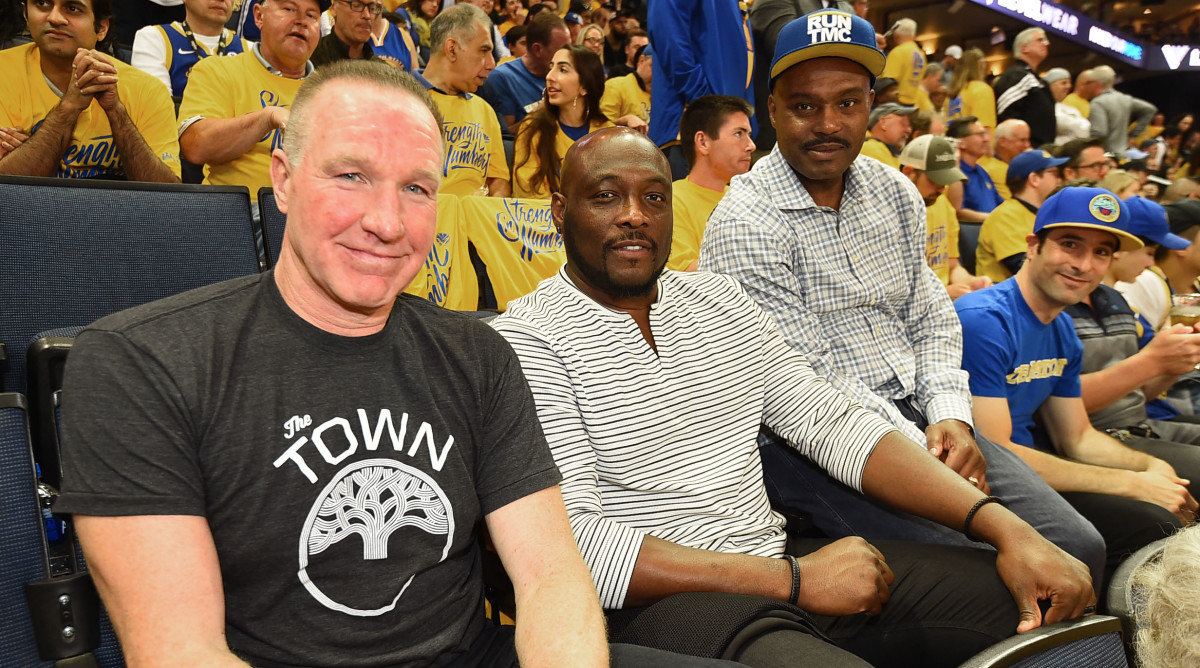
In 2001, Mullin retired, after a one-year reunion with the Warriors that followed a three-season interlude in Indiana. Richmond left the NBA after the 2001–02 season, when he played sparingly for the Lakers but dribbled out the final seconds of their championship year. He remains the only Run TMC member to win a title. Hardaway departed the NBA the following season, retiring as Miami’s franchise leader in assists.
Nelson tried to assemble a Run TMC reunion tour when he was coaching the Mavericks in 2002. It didn’t happen. But most of the principals did end up back together in the place where it all began. The Warriors handed Mullin control of their basketball operations in ’04, and he hired Higgins as his general manager and Richmond as his special assistant. Elie became an assistant coach. Their management jobs even loosely resembled the way they played together: Mullin in charge, Richmond the trusted confidant and Higgins and Elie sliding into pivotal roles alongside them.
After two 34-win seasons under coach Mike Montgomery, Mullin decided to make a change. He hired a familiar face: Nelson. Behind the scenes Nellie had a surprising advocate in Richmond, despite the fact that the two hadn’t spoken. “I wasn’t truly over it,” he says. “But when we put the team together, we had trouble figuring out what was missing. Nellie was the only one to run that team, because it was pretty much made up of how we were.”
That first Golden State roster under the Mullin-Nelson stewardship featured scorers such as Baron Davis, Monta Ellis and Jason Richardson; long, versatile forwards such as Stephen Jackson and Al Harrington; and a point-forward in Mike Dunleavy Jr. (Sound familiar?) Sometimes those Warriors would see their coaches and executives, on the court, skipping lunch to sweat through physical two-on-two affairs, just like in the old days.
That team, nicknamed the We Believe squad, snuck into the playoffs with 42 wins, ending a 12-year postseason drought, and then knocked off the top-seeded Mavericks. Two years later the Dubs were a 29-win team and Mullin was out, followed a year later by Nelson. Golden State didn’t make the playoffs again until 2013, when boosted by another trio: Curry, Thompson and Draymond Green.
Mullin went into the basketball Hall of Fame in 2011, and he suggested then that Golden State should raise the three Run TMC jerseys to the rafters all at once. Richmond joined him in Springfield in 2014; he was inducted as a King rather than a Warrior, against his wishes. All the while both advocated for the induction of Hardaway, the originator of the Killer Crossover and the second-fastest player to 5,000 career points and 2,500 career assists, behind only Oscar Robertson.
Like his former teammates, Hardaway eventually got into coaching, becoming a Detroit Pistons assistant in 2014. Mullin took over the college program at his alma mater the next year. His first hire? Richmond. Of course.
Hardaway drilled into his charges the importance of developing a complete skill set. He wanted his forwards to master dribbling, deliver crisp passes and shoot accurately from outside. That’s what basketball was becoming, a game predicated on motion and pace and versatility, with traditional bigs becoming less and less important. (Sound familiar?) If historians look hard enough, Richmond says, they can trace the evolution of pro basketball from Run TMC to We Believe to the current Warriors juggernaut.
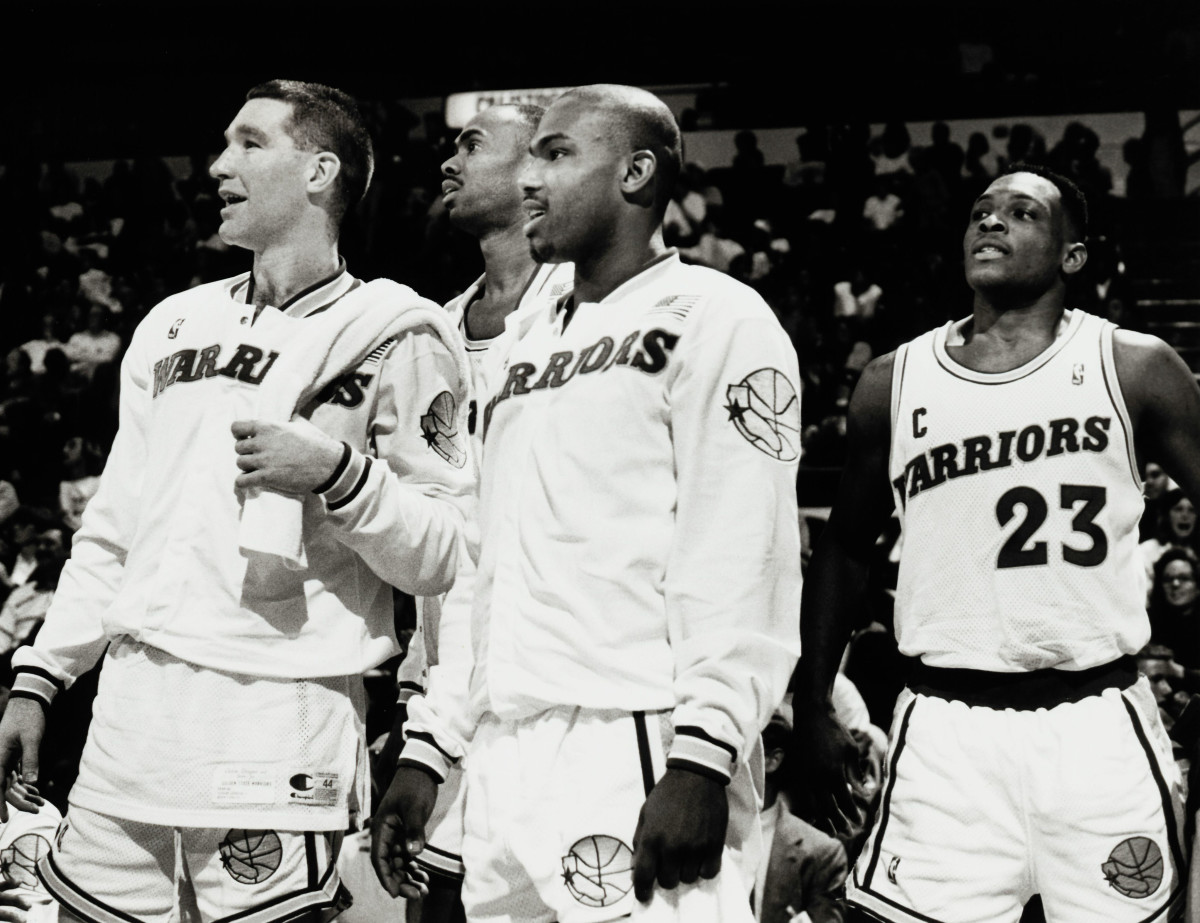
Hardaway stands inside a hotel ballroom on that May evening, underneath ornate gold ceilings, next to his bronze Bay Area Sports Hall of Fame bust. He’s joined by his wife, two daughters and son, Tim Jr., a 26-year-old Knicks guard who is a reminder to Run TMC of just how much time has passed.
A man in salmon pants rushes over for a picture. “Mr. Killer Crossover!” he shouts. “What a pleasure to meet you!” Hardaway mingles with everyone from Brandi Chastain to Jed York to Ronnie Lott. Eventually he’s introduced, and he walks to the stage, where he’s seated next to two old friends. They’re here to introduce him.
Richmond calls Hardaway one of the best point guards in NBA history. He mimics the high pitch in Hardaway’s voice, the way he’d yell “Owwww!” in attempts to draw foul calls. Mullin says Hardaway was Curry before Curry, Harden before Harden. He saw Hardaway finish at the rim against Hakeem Olajuwon—back, he says, when real centers played. The crowd oohs. “We had a few get-togethers where we’re like, We could take Steph, Klay and Draymond,” Mullin says. “But not with Durant. Now it’s over. Now, we got no chance.”
The crowd cheers, then stands and roars, louder, more proof that Run TMC still resonates beyond YouTube highlight montages, throwback jerseys and vintage posters of the three posing in front of a wall splattered with graffiti, with them wearing gym shorts and leather jackets. If not exactly fashion forward, they made basketball cooler, stamped their imprint on the NBA and helped launch the small-ball revolution.
Hardaway still gets approached in airports. If the person mentions TMC he knows they’re at least 38 or 39, old enough to appreciate the influential trio’s place in NBA history. It’s predicated on what the threesome could have been rather than what it was. A weird legacy. But it’s theirs. “I hear from people all the time, man,” Hardaway says. “Run TMC! Y’all were some bad motherf-------. Y’all gave me joy.”
With special reporting from Ben Golliver.
